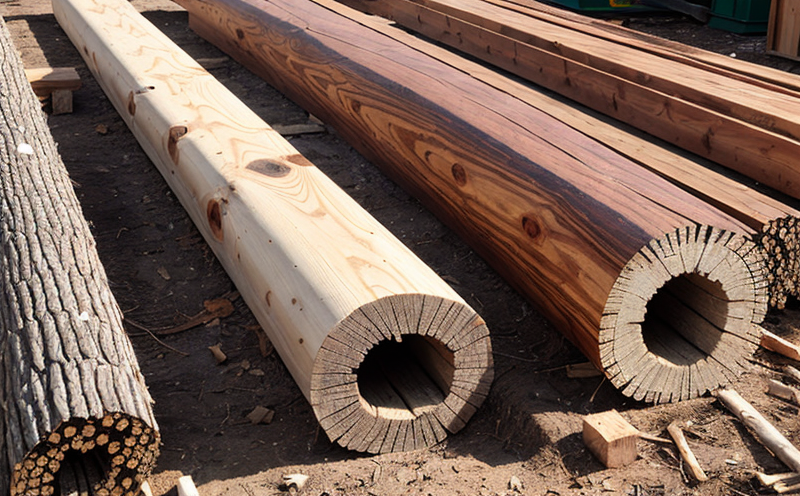Termite Field Exposure Testing of Treated Wood
The termite field exposure testing of treated wood is a critical component in ensuring that structural timber used in agricultural and forestry applications remains durable and resistant to termites over time. This test is essential for quality managers, compliance officers, R&D engineers, and procurement professionals involved in the design, manufacturing, and certification processes for treated wood products.
The process simulates real-world conditions where wood might encounter termite infestations. By exposing the wood to natural termite populations under controlled field conditions, this test provides a reliable assessment of how effective the preservative treatment is against termites. This information is crucial for ensuring that treated wood meets regulatory requirements and performs reliably in its intended applications.
The testing involves placing samples of treated wood in designated locations where they are exposed to termite populations for an extended period, typically several years. The specimens are monitored regularly to observe any signs of infestation or decay caused by termites. This approach helps researchers and engineers understand the long-term performance of preservative treatments under realistic conditions.
Understanding the specifics of this testing is important because it ensures that wood products used in agricultural and forestry applications remain safe and effective for decades. The results can be used to improve formulations, enhance treatment methods, or inform regulatory compliance strategies. This is particularly valuable in regions where termite infestations are common.
The scope of the test includes a wide range of treated wood products such as fence posts, poles, pilings, and other structural elements that might be prone to termites. The methodology focuses on replicating real-world exposure by placing specimens in areas with known termite populations. This ensures that the results are relevant to actual field conditions.
The testing process involves several key steps: specimen preparation, placement, monitoring, and data analysis. Specimens must be cut into standard sizes to ensure consistency across different tests. After treatment, these samples are placed in predetermined locations where they can interact with termites over an extended period. Monitoring involves regular inspections to assess any signs of termite activity or wood degradation.
Data collected during the test is crucial for evaluating the effectiveness of preservative treatments. This includes noting the presence and extent of termite infestations, the rate of wood decay, and other relevant parameters. The results are then used to determine whether the treated wood meets specified performance standards or if adjustments to treatment methods are necessary.
Understanding the real-world implications of this testing is vital for ensuring that agricultural and forestry applications remain sustainable and safe over time. By leveraging termite field exposure testing, stakeholders can make informed decisions about product design, manufacturing processes, and regulatory compliance strategies. This approach not only enhances product performance but also contributes to environmental sustainability by reducing waste and promoting the use of durable materials.
The importance of this test cannot be overstated, especially in regions where termite infestations pose a significant threat to wooden structures. By providing accurate and reliable data on treatment effectiveness, it helps protect investments in treated wood products while ensuring compliance with international standards such as ISO 6722.
Scope and Methodology
The scope of termite field exposure testing is broad, encompassing various types of treated wood used in agricultural and forestry applications. This includes fence posts, poles, pilings, and other structural elements that might be prone to termites.
- Specimen Preparation: Samples are cut into standard sizes for consistency.
- Treatment Application: Specimens undergo preservative treatments according to specific protocols.
- Placement: Treated specimens are placed in predetermined locations where they can interact with termites over an extended period.
- Monitoring: Regular inspections assess any signs of termite activity or wood degradation.
The methodology focuses on replicating real-world exposure by placing specimens in areas with known termite populations. This ensures that the results are relevant to actual field conditions, providing reliable data on treatment effectiveness.
Benefits
- Accurate assessment of preservative efficacy under real-world conditions.
- Enhanced durability and longevity of treated wood products in agricultural and forestry applications.
- Supports compliance with international standards such as ISO 6722.
- Promotes sustainable use of materials by reducing waste and extending product life.
- Improves product performance through informed decision-making based on reliable data.
This testing ensures that agricultural and forestry professionals can make well-informed decisions about the design, manufacturing, and certification processes for treated wood products. By leveraging accurate data from field exposure tests, stakeholders can enhance product durability and promote sustainable practices.
Why Choose This Test
- Prediction of long-term performance under real-world conditions.
- Compliance with international standards such as ISO 6722.
- Enhanced durability and longevity of treated wood products.
- Support for sustainable practices by reducing waste and extending product life.
The termite field exposure testing is a critical tool for ensuring the reliability and effectiveness of preservative treatments. By choosing this test, stakeholders can make informed decisions about product design, manufacturing processes, and regulatory compliance strategies. This approach not only enhances product performance but also contributes to environmental sustainability.





